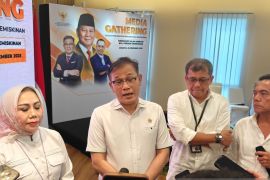The Central Bureau of Statistics (BPS) revealed that the number of people living below the poverty line had dropped to 25.95 million, or 9.82 percent of the population in March 2018, from 27.77 million, or 10.64 percent of the population a year earlier.
"The poverty ratio (in March 2018) was the lowest in comparison with the ratios in the earlier periods," BPS Head Suhariyanto informed reporters in Jakarta on July 16, 2018.
Across Indonesia, the number of people categorized as poor in March 2018 had dropped to 1.82 million from that recorded a year earlier.
In urban areas, the number of poor in urban areas in March 2018 totaled 10.14 million people, or 7.02 percent, and in rural areas, 15.81 million, or 13.2 percent.
In March 2017, the number of poor people in urban areas had reached 10.67 million, or 7.72 percent, while in urban areas, the figure totaled 17.1 million, or 13.93 percent.
Food commodities having a major impact on poverty in urban and rural areas are rice, cigarettes, eggs, instant noodles, and refined sugar, while non-food commodities include housing, gasoline, electricity, education, and toiletry.
At the regional level, the lowest poverty rate was recorded in Kalimantan, at 6.09 percent, totaling 982,300 people.
The number of poor in Java reached 13.34 million, followed by Sumatra, 5.9 million; and Sulawesi, two million.
A decline in the poverty ratio was recorded in five provinces: Central Java, down 0.91 percent; South Sulawesi, a drop of 0.43 percent; West Java, a decrease of 0.38 percent ; Banten, a 0.36 percent decline; and Southeast Sulawesi, down 0.35 percent.
However, an increase in the poverty ratio was recorded in five provinces: Jambi, up 0.03 percent; Aceh, 0.05 percent; West Sulawesi, 0.07 percent ; the Riau Islands, 0.08 percent; and Lampung, 0.10 percent.
In the meantime, Maluku and Papua have recorded the highest poverty ratio of 21.20 percent, followed by Bali and Nusa Tenggara, 14.02 percent, which are all located in the eastern Indonesian region.
East Nusa Tenggara (NTT), for instance, remained the third-poorest province in the country, after Papua, with a poverty ratio of 27.74 percent, and West Papua, with a poverty ratio of 23.01 percent, although NTT`s poverty ratio had dropped slightly, according to Head of the NTT BPS office Maritje Pattiwaellapia.
NTT`s poverty ratio dropped slightly to 21.35 percent in March 2018, from 21.36 percent in September 2017.
A total of 1,142,170 people in the province, with a population of 5.2 million, were categorized as poor.
Basically, the percentage of people living in poverty in the eastern part of Indonesia in March 2018 was still higher than that of the western part.
"It (the poverty rate) mostly fell, but it remains a major homework in the eastern part of Indonesia, as the percentage of its poor people is far higher than that of the western part," BPS Chief Suhariyanto pointed out.
Suhariyanto expressed hope that several infrastructure projects being implemented in the eastern part of Indonesia would help to reduce the number of people living in poverty there.
"Hence, development activities in the eastern part of Indonesia would hopefully have a positive impact on the reduction in poverty rate there," he asserted.
In fact, World Bank has advised that better logistics will boost the country`s competitiveness and also help reduce poverty by lowering the prices of goods and services in remote regions, especially in Eastern Indonesia.
"Efficient maritime logistics are vital for higher growth of the manufacturing, agriculture, and service sectors," World Bank Country Director for Indonesia and Timor-Leste Rodrigo A. Chaves noted in a statement.
Meanwhile, the Government of Indonesia will set its focus on the development of Independent Prosperous Village (DSM) as part of the efforts to address poverty in border regions.
"We will focus on the development of Independent Prosperous Village in some 41 districts and cities that have border regions to address the issue of poverty and improve the people`s welfare," Social Affairs Minister Idrus Marham remarked recently.
Marham believes that if citizens in border regions are prosperous, then the resilience of the state will also be robust.
The social affairs minister stated that universities are being involved in the development of DSM at the field level by deploying students to conduct Real Work Lecture, or KKN.
The Social Affairs Ministry`s partnership with universities in developing the DSM program began in 2015, with the development of 140 villages to become independent in realizing prosperity.
The DSM program is a new breakthrough in a bid to accelerate the handling of poverty. Universities are expected to act as initiators and guides based on their potential, capacity, and capability, while the Ministry of Social Affairs will function as the facilitator and director.
(f001/INE/B003)
EDITED BY INE
(T.F001/A/KR-BSR/B003) 17-07-2018 19:09:24
Reporter: Fardah
Editor: Fardah Assegaf
Copyright © ANTARA 2018












